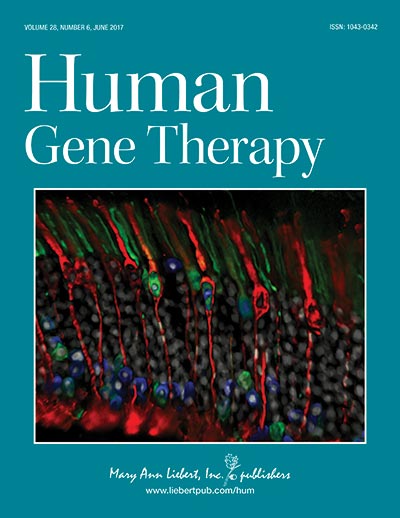For Immediate Release
Researchers Describe Novel Reporter Proteins for Tracking Long Term Expression of Therapeutic Genes
Contact: Kathryn Ryan
914-740-2250
kryan@liebertpub.com

New Rochelle, NY, July 11, 2017—A new study showed that the expression levels of a novel secreted reporter protein delivered to an immunosuppressd large animal model could be detected for several months after infusion into the liver, demonstrating the potential to monitor the effectiveness of delivery and ongoing expression of a therapeutic gene. The genes were packaged and delivered to the liver using the nonviral Sleeping Beauty transposon system, as described in an article published in Human Gene Therapy, a peer-reviewed journal from Mary Ann Liebert, Inc., publishers. The article is available free on the Human Gene Therapy website until August 11, 2017.
In the article entitled "Transgene Expression in Dogs After Liver-Directed Hydrodynamic Delivery of Sleeping Beauty Transposons Using Balloon Catheters," R. Scott McIvor and coauthors from University of Minnesota, and Discovery Genomics, Minneapolis, MN showed that they were able to infuse DNA solutions into the liver and measure the levels of a reporter protein in the blood for up to 6 weeks. This method could be used for real-time monitoring of the expression of therapeutic genes delivered to target tissues such as the liver.
Additional research from R. Scott McIvor's laboratory at the University of Minnesota and Discovery Genomics showed the presence of a reporter protein in the blood of immunosuppressed dogs' blood for up to 5.5 months after infusion, compared to up to 6 weeks in the previous study in dogs not treated with an immunosuppressive agent. In the article "Prolonged Expression of Secreted Enzymes in Dogs after Liver-Directed Delivery of Sleeping Beauty Transposons: Implications for Non-Viral Gene therapy of Systemic Disease," Elena Aronovich et al. concluded that more research is needed to identify alternative methods capable of achieving therapeutic levels of the transgene products.
“The work from the McIvor lab has combined the excellent safety and high capacity of non-viral systems, with the durability created by transposon-mediated integration,” says Editor-in-Chief Terence R. Flotte, MD, Celia and Isaac Haidak Professor of Medical Education and Dean, Provost, and Executive Deputy Chancellor, University of Massachusetts Medical School, Worcester, MA. “The new breakthrough here is proving that a hydrodynamic liver-targeted delivery process can be scaled up from mice to large mammals, and potentially humans, thus surmounting the obstacle of delivering the therapeutic transposon payload to the liver efficiently.”
Research reported in this publication was supported by the National Institutes of Health under Award Numbers R44 HL072539, R41 DK081249, and R01 DK082516. The content is solely the responsibility of the authors and does not necessarily represent the official views of the National Institutes of Health.
About the Journal
Human Gene Therapy, the Official Journal of the European Society of Gene and Cell Therapy, British Society for Gene and Cell Therapy, French Society of Cell and Gene Therapy, German Society of Gene Therapy, and five other gene therapy societies, is an authoritative peer-reviewed journal published monthly in print and online. Led by Editor-in-Chief Terence R. Flotte, MD, Celia and Isaac Haidak Professor of Medical Education and Dean, Provost, and Executive Deputy Chancellor, University of Massachusetts Medical School, Human Gene Therapy presents reports on the transfer and expression of genes in mammals, including humans. Related topics include improvements in vector development, delivery systems, and animal models, particularly in the areas of cancer, heart disease, viral disease, genetic disease, and neurological disease, as well as ethical, legal, and regulatory issues related to the gene transfer in humans. Its companion journals, Human Gene Therapy Methods, published bimonthly, focuses on the application of gene therapy to product testing and development, and Human Gene Therapy Clinical Development, published quarterly, features data relevant to the regulatory review and commercial development of cell and gene therapy products. Tables of contents for all three publications and a free sample issue may be viewed on the Human Gene Therapy website.
About the Publisher
Mary Ann Liebert, Inc., publishers is a privately held, fully integrated media company known for establishing authoritative peer-reviewed journals in many promising areas of science and biomedical research, including Nucleic Acid Therapeutics, Tissue Engineering, Stem Cells and Development, and Cellular Reprogramming. Its biotechnology trade magazine, GEN (Genetic Engineering & Biotechnology News), was the first in its field and is today the industry’s most widely read publication worldwide. A complete list of the firm’s 80 journals, books, and newsmagazines is available on the Mary Ann Liebert, Inc., publishers website.
Mary Ann Liebert, Inc. 140 Huguenot St., New Rochelle, NY 10801-5215 www.liebertpub.com
Phone: (914) 740-2100 (800) M-LIEBERT Fax: (914) 740-2101